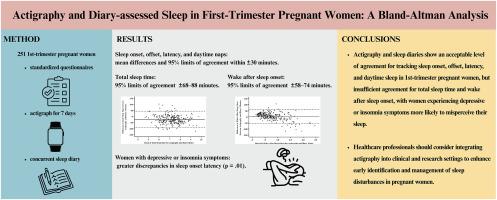活动记录仪和日记评估妊娠早期妇女的睡眠:一项Bland-Altman分析。
IF 3.4
2区 医学
Q1 CLINICAL NEUROLOGY
引用次数: 0
摘要
研究目的:评价活动描记和孕妇睡眠日记之间的一致性,并检查睡眠相关症状对这种一致性的影响。方法:选取台北市某大学附属医院产前门诊251例初孕期孕妇。参与者完成标准化的症状问卷,并佩戴活动记录仪7天,同时保持同步睡眠日记。Bland-Altman方法被用于评估活动描记法和日记睡眠测量法之间的一致性。采用非配对t检验来分析两种方法之间睡眠相关症状和睡眠测量差异之间的关联。结果:睡眠开始、偏移、睡眠开始潜伏期和白天睡眠持续时间的平均差异及其95%的一致性限制在±30分钟内。总睡眠时间和睡眠开始后醒来时间的一致性范围更广,达到95%,分别为±68至±88分钟和±58至±74分钟。抑郁或失眠症状加重的女性在睡眠开始潜伏期上的差异大于没有这些症状的女性(p = 0.01)。结论:活动记录仪和睡眠日记在追踪妊娠早期妇女的睡眠开始时间、偏移时间、睡眠开始潜伏期和白天睡眠持续时间方面显示出可接受的一致性,但在总睡眠时间和睡眠开始后的醒来时间方面的一致性不足,有抑郁或失眠症状的妇女更容易误解自己的睡眠。医疗保健专业人员应考虑将活动记录仪纳入临床和研究环境,以加强对孕妇睡眠障碍的早期识别和管理。本文章由计算机程序翻译,如有差异,请以英文原文为准。

Actigraphy and diary-assessed sleep in first-trimester pregnant women: A Bland-Altman analysis
Study objectives
To evaluate the agreement between actigraphy and sleep diaries in pregnant women and to examine the impact of sleep-related symptoms on this agreement.
Methods
A total of 251 first-trimester pregnant women were recruited from prenatal clinics at a university-affiliated hospital in Taipei, Taiwan. Participants completed standardized symptom questionnaires and wore an actigraph for 7 days while maintaining a concurrent sleep diary. The Bland-Altman method was applied to assess the agreement between actigraphy and diary-derived sleep measures. Unpaired t-tests were performed to analyze associations between sleep-related symptoms and discrepancies in sleep measures between the two methods.
Results
Mean differences for sleep onset, offset, sleep onset latency, and daytime sleep duration, along with their 95 % limits of agreement, were within ±30 min. Total sleep time and wake after sleep onset had wider 95 % limits of agreement, ranging from ±68 to ±88 min and ±58 to ±74 min, respectively. Women with elevated symptoms of depression or insomnia showed greater discrepancies in sleep onset latency than those without such symptoms (both p = .01).
Conclusions
Actigraphy and sleep diaries show an acceptable level of agreement for tracking sleep onset time, offset time, sleep onset latency, and daytime sleep duration in first-trimester pregnant women, but insufficient agreement for total sleep time and wake after sleep onset, with women experiencing depressive or insomnia symptoms more likely to misperceive their sleep. Healthcare professionals should consider integrating actigraphy into clinical and research settings to enhance early identification and management of sleep disturbances in pregnant women.
求助全文
通过发布文献求助,成功后即可免费获取论文全文。
去求助
来源期刊

Sleep medicine
医学-临床神经学
CiteScore
8.40
自引率
6.20%
发文量
1060
审稿时长
49 days
期刊介绍:
Sleep Medicine aims to be a journal no one involved in clinical sleep medicine can do without.
A journal primarily focussing on the human aspects of sleep, integrating the various disciplines that are involved in sleep medicine: neurology, clinical neurophysiology, internal medicine (particularly pulmonology and cardiology), psychology, psychiatry, sleep technology, pediatrics, neurosurgery, otorhinolaryngology, and dentistry.
The journal publishes the following types of articles: Reviews (also intended as a way to bridge the gap between basic sleep research and clinical relevance); Original Research Articles; Full-length articles; Brief communications; Controversies; Case reports; Letters to the Editor; Journal search and commentaries; Book reviews; Meeting announcements; Listing of relevant organisations plus web sites.
 求助内容:
求助内容: 应助结果提醒方式:
应助结果提醒方式:


